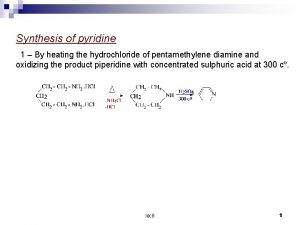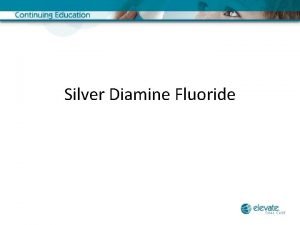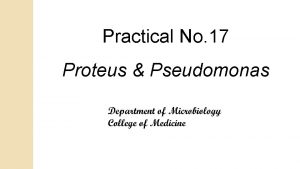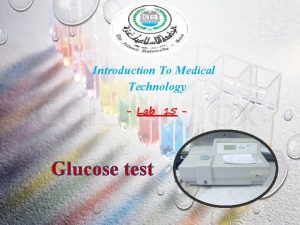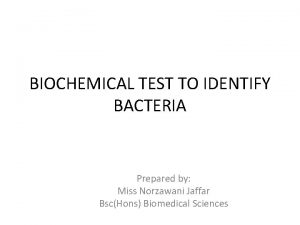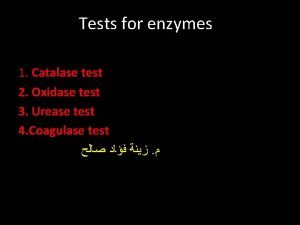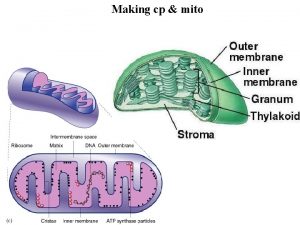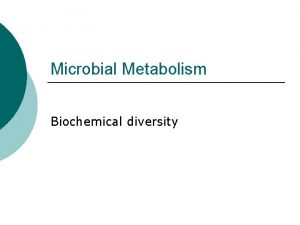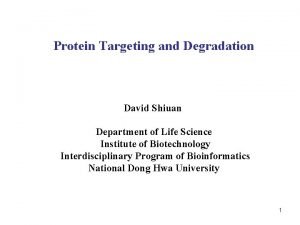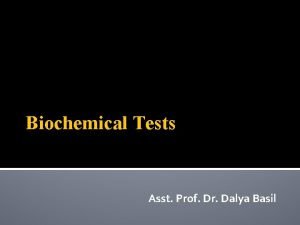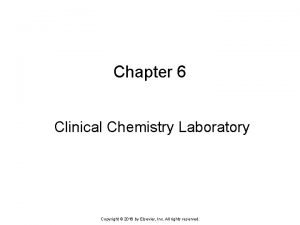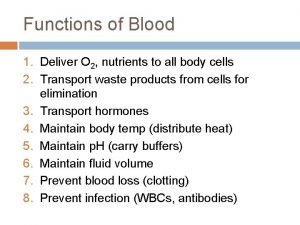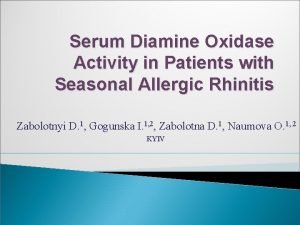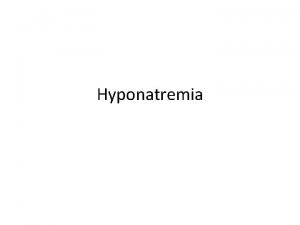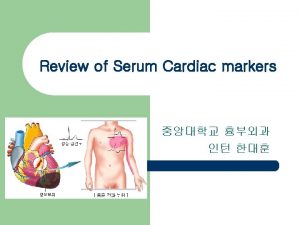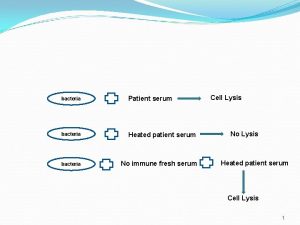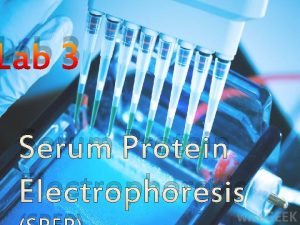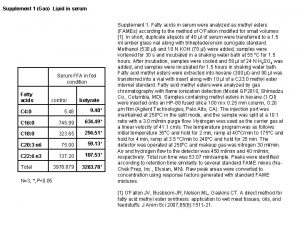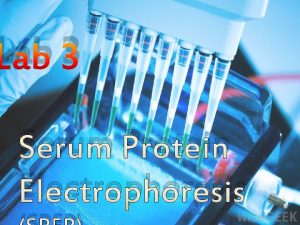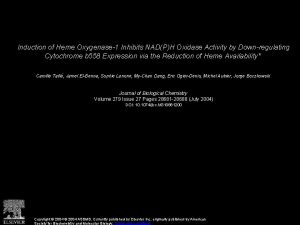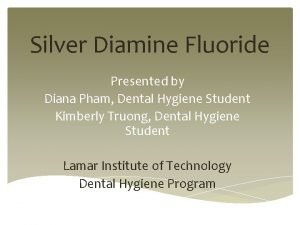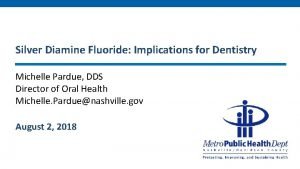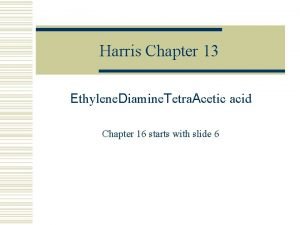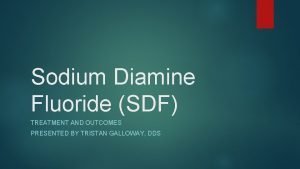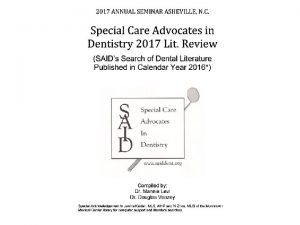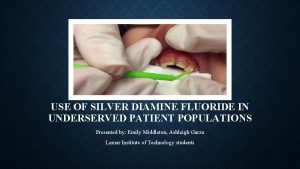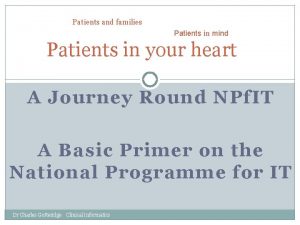Serum Diamine Oxidase Activity in Patients with Seasonal

























- Slides: 25

Serum Diamine Oxidase Activity in Patients with Seasonal Allergic Rhinitis Zabolotnyi D. 1, Gogunska I. 1, 2, Zabolotna D. 1, Naumova O. 1, 2 KYIV

According to the World Health Organization, around 400 million people worldwide had allergic rhinitis in 2014. Prevalence was highest in Europe with around 1 in 4 Europeans suffering from the disease.

In 2012, 11. 1 million people were diagnosed with allergic rhinitis in U. S. 1 Allergies are increasing. They affect as many as 30 percent of adults and 40 percent of children. 1 American College of Allergy, Asthma, and Immunology. Allergy Facts. http: //acaai. org/news/facts-statistics/allergies (Retrieved April 8 2015)

The prevalence of seasonal allergic rhinitis (SAR) among adult population makes up 8 -10% worldwide. 40 -70% of patients with SAR have concomitant cross reaction pollen food allergy (CRPFA). CRPFA – adverse reactions upon the ingestion of plant-derived foods as a result of Ig. E crossreactive structures shared by pollen and food allergen sources. The symptoms range from oral allergy syndrome to severe anaphylaxis.

Allergy Examples Symptoms Rhinoconjunctivitis and rhinorrhea Urticaria and angioedema �� Headaches � Symptoms in the oral cavity � Digestive tract disturbances: abdominal pain, diarrhea, nausea, vomiting Similar symptoms can be caused by histamine intolerance

Role of histamine in the allergy symptoms Traditionally, allergy is defined as a Type I Ig. E hypersensitivity reaction Histamine is the most important inflammatory mediator in Ig. E released from mast cells by degranulation of other granulocytes, especially basophils

Histamine is a biologically active derivative of an amino acid (histidine) Most foods and beverages contain histamine High doses are toxic to humans: levels of >2. 7 mg/kg body weight cause “histamine poisoning” Individual tolerance determines reactivity to small quantities

Theories on Histamine Excess Histamine from dietary sources and from the activity of intestinal microorganisms will normally be catabolized before gaining access to circulation If enzyme activity is reduced, histamine will gain access to blood and augment the level of plasma histamine from endogenous sources

Food Sources of Histamine Fermented beverages: Wine, Beer etc. � Fruits: Citrus fruits, raspberries, strawberries bananas, pineapples, grapes, currants, pears and fruit juice Vegetables: Tomato and tomato products eggplants, soy beans, olives

Individual Intolerance of Histamine Cause is most likely a defect in the catabolism of histamine � In humans, enzymatic inactivation of histamine occurs by two pathways: – Diamine oxidase (DAO) – Histamine N-methyl transferase (HMT)

Reduced Histamine Catabolism Indicators of reduced histamine metabolism have been suggested to be: – Elevated plasma histamine (>2 ng/ml) – Reduced DAO activity (<7 u/m. L) Reduced histamine catabolism, combine with Ig. Emediated histamine release suggested to result in increased severity of allergy – may be a critical factor in anaphylaxis

Histamine intolerance results from disequilibrium of accumulated histamine and the capacity for histamine degradation. The main enzyme for metabolism of ingested histamine is diamine oxidase (DAO). It has been proposed that DAO as a secretory protein might be responsible for scavenging extracellular histamine after mediator release. Laura Maintz and Natalija Novak Histamine and histamine intolerance ; Am J Clin Nutr 2007; 85: 1185– 96.

Pathogenesis The production of DAO may for example be reduced by damage to enterocytes in gastrointestinal disease 1, 2. Other biogenic amines, alcohol 3 and medications 4, 5 can also competitively inhibit the breakdown of histamine by DAO. Acquired histamine intolerance may be reversible where the cause is removed, such as the discontinuation of DAO blocking medications. 1. Schmidt WU, Sattler J, Hesterberg R et al. : Human intestinal diamine oxidase (DAO) activity in Crohn's disease: a new marker for disease assessment? Agents Actions 1990; 30: 267– 70. 2. Raithel M, Matek M, Baenkler HW, Jorde W, Hahn EG: Mucosal histamine content and histamine secretion in Crohn‘s disease, ulcerative colitis and allergic enteropathy. Int Arch Allergy Immunol 1995; 108: 127– 33. 3. Wantke F, Hemmer W, Haglmuller T, Gotz M, Jarisch R: Histamine in wine. Bronchoconstriction after a double-blind placebo-controlled red wine provocation test. Int Arch Allergy Immunol 1996; 110: 397– 400 4. Sattler J, Lorenz W: Intestinal diamine oxidases and enteral-induced histaminosis: studies on three prognostic variables in an epidemiological model. J Neural Transm Suppl 1990; 32: 291– 314. 5. Sattler J, Hesterberg R, Lorenz W, Schmidt U, Crombach M, Stahlknecht CD: Inhibition of human and canine diamine oxidase by drugs used in an intensive care unit: relevance for clinical side effects? Agents Actions 1985; 16: 91– 4.

Pathogenesis Various DAO polymorphisms have been identified in association with inflammatory and neoplastic diseases such as food allergies, sprue, Crohn's disease, ulcerative colitis and colonic adenomas 1, 2, 3 giving rise to discussion of a partially DAO associated genetic predisposition to the development of the disease 4. 1. Petersen J, Drasche A, Raithel M, Schwelberger HG: Analysis of genetic polymorphisms of enzymes involved in histamine metabolism. Inflamm Res 2003; 52 (Suppl. 1): S 69– 70. 2. Schwelberger HG, Drasche A, Petersen J, Raithel M: Genetic polymorphisms of histamine degrading enzymes: from small-scale screening to high-throughput routine testing. Inflamm Res 2003; 52 (Suppl. 1): S 71– 3. 3. Petersen J, Raithel M, Schwelberger HG: Histamine N-methyltransferase and diamine oxidase gene polymorphisms in patients with inflammatory and neoplastic intestinal diseases. Inflamm Res 2002; 51 (Suppl. 1): S 91– 2. 4. Schwelberger HG: Diamine oxidase (DAO) enzyme and gene. In: Falus A, editor: Histamine: Biology and Medical Aspects. Budapest: Spring Med Publishing 2004; 43– 52.

Indicators of Possible Histamine Intolerance Skin tests: Large reaction of wheal to histamine control being kept positive for more than 50 minutes Unusuall sensitivity to: alcoholic beverages, fermented foods, especially oriental food, cheese, vinegar Sensitivity to benzoate-containing foods, especially cinnamon, green and black tea Positive family history

Clinical findings Patients frequently complain of headache, rhinitis, flushing, diarrhea, tachycardias or arrhythmias following ingestion of specific foods. Because these symptoms are reminiscent of allergy, allergy testing is usually performed. However, these tests are often negative for an Ig. E mediated immune response. In these cases, histamine intolerance should be considered as a possible diagnosis.

Histamine intolerance Of the 1% of the population who suffer from histamine intolerance 80 % are middle aged women. Jarisch R, Götz M, Hemmer W, Missbichler A, Raithel M, Wantke F: Histamin-Intoleranz. Histamin und Seekrankheit. 2 ed. Stuttgart. New York: Georg Thieme Verlag 2004.

OBJECTIVES: To investigate the incidence of HITS in SAR patients with and without CRPFA. To measure DAO levels in SAR patients with and without CRPFA.

Materials and methods 217 patients (ages 18 to 55, mean age of 36, 2) suffering from SAR with sensibilization to tree pollen filled questionnaires. Questionnaires were designed in our Institute. DAO level was determined by radio-enzyme assay HITS was established on the basis of self-report collected with the patient questionnaires. Patients were divided into groups according to the presence of HITS and DAO levels.

SAR: seasonal allergic rhinitis; CRPFA: cross reaction pollen food allergy; HITS: histamine intolerance syndrome; DAO: diamine oxidase levels; >10 U/m. L DAO: normal DAO levels.

CLINICAL SYMPTOMS AFTER CONSUMPTION OF HIGH HISTAMINE FOODS IN PATIENTS WITH SAR WITH AND WITHOUT CRPFA AS ASSESSED WITH PATIENT QUESTIONNAIRE

Results Only 1% of patients with SAR without CRPFA demonstrates signs of HITS that correlates with data in total population. Among patients with SAR and CRPFA, the number of persons diagnosed with HITS was more than 10 times greater (10. 4%). In accordance with the results of the analysis of questionnaires of patients with SAR and SAR+CRPFA, in patients with HITS various clinical manifestations of intolerance to food with a high content of histamine have been identified.

The prevalence of HITS in SAR patients with and without CRPFA determined from DAO levels 12, 00% 10, 00% 8, 00% 6, 00% 4, 00% 2, 00% 0, 00% SAR+CRPFA

Results The most common symptoms that occurred after consuming products with a high level of histamine were flatulence, rhinorrhea, urticaria, nasal obstruction and pruritis. The combination of symptoms "nasal obstruction + rhinorrhea + pruritis + diarrhea" was only seen in patients with SAR and CRPFA.

Conclusion The presence of concomitant HITS in patients with SAR and CRPFA might worsen the course of allergy due to the high levels of blood histamine after consumption of high histamine foods. Patients with SAR+CRPFA+HITS might benefit from histamine-restricted diet. In our further research we are going to evaluate the effectiveness of such diet in SAR+CRPFA+HITS patients.
 Silver diamine fluoride brighton
Silver diamine fluoride brighton Pentamethylene diamine hydrochloride
Pentamethylene diamine hydrochloride Advantage arrest silver diamine fluoride instructions
Advantage arrest silver diamine fluoride instructions Catechol oxidase and potato extract lab report
Catechol oxidase and potato extract lab report Keto-enol-tautomerie fructose
Keto-enol-tautomerie fructose Mycobacterium oxidase test
Mycobacterium oxidase test Moraxella catarrhalis oxidase
Moraxella catarrhalis oxidase Test
Test Positive for catalase
Positive for catalase Types of blood glucose test
Types of blood glucose test Litmus milk decolorization test
Litmus milk decolorization test Urease positive bacteria
Urease positive bacteria Advantages of glucose oxidase method slideshare
Advantages of glucose oxidase method slideshare Alternative oxidase in plants
Alternative oxidase in plants Glycolytic pathways
Glycolytic pathways Enterobacteriaceae classification
Enterobacteriaceae classification Mannose nmr
Mannose nmr Oxidase results
Oxidase results Salmonella oxidase test
Salmonella oxidase test Oxidase test
Oxidase test Catalase test procedure
Catalase test procedure Altering drug metabolism
Altering drug metabolism Osmolarity formula
Osmolarity formula Zohair serum
Zohair serum Plazma osmolalitesi
Plazma osmolalitesi Functions of blood
Functions of blood

